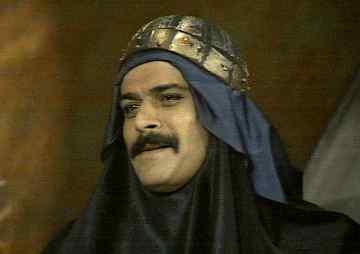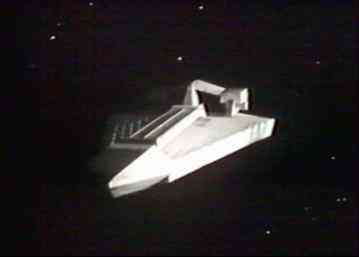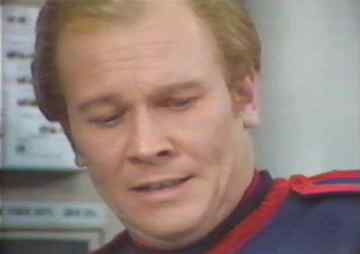
Presumably a creature of some sort, possibly from Tarsius and no doubt much given to the strangling of hapless wargs. Vila said that Tarrant had "about as much subtlety as a Tarsian Warg-strangler", which doesn't appear to be a lot.
One of the planets taken by the Federation under Commissioner Sleer's Pacification Programme, along with Luba, Porphyr Major and Helotrix. Mentioned by Leitz, who noted that industrial production there had risen 19% after adaptation, an example of the way in which pylene-50 could reinforce the work ethic.
| Leader of the Amagon pirates who captured the Liberator using a false distress call from the civilian cruiser Star Queen. He had previously known Jenna on Zolat-4, where they had hid in the mountains from three hundred customs guards. Jenna saved Tarvin's life in this incident, but how or why was never specified. He offered not to sell Jenna to the Federation, but put little trust in her. He was eventually shot dead by Sarkoff. |  |
Crewman of the London, and along with Wallace the first person to cross to the drifting Liberator. It is not quite clear which of the two was Teague, but he may have been the crewman who used the remote lock activator to open the hatch on Liberator and was later found dead on the flight deck.
| A deep space passenger liner. Announcements made reference to "first class dining salons" so it probably carried more than one class of passenger (as one might expect). Deeta Tarrant was aboard when declaration of war between Teal and Vandor was declared. The observation gallery later appeared as the combat ground chosen for Tarrant's duel with Vinni. |  |
The convention between the United Planets of Teal and the Vandor Confederacy by which war between the two systems was averted. Disputes were resolved by champions of each system in computer-selected environments, each champion having the same weapons and any necessary survival equipment. Combat was to the death, and the losing side was obliged by the Convention to surrender two thirds of their fleet and three planets.
Relatives of defeated champions could issue a challenge by right of blood feud, a right Tarrant exercised to avenge his brother and dispose of Vinni (use of a weapon of his own choice was not mentioned as a violation of the rules). A former blood feud was also mentioned regarding Racov, Vinni's predecessor. Victory by the challenger led to him (or, presumably, her) becoming the new champion of the system in question. Attempting to kill a Champion outside a period of declared hostilities invoked a Summons to Justification.
The process was overseen by three arbiters, one from each system and a neutral. Sensornet implants in the champions allowed distant observers to "participate" in the combat, a rare allusion in the series to virtual reality. Combats were a major event, widely televised and bedecked with ceremony and ritual. Vila described them as "the most fun you could have with your clothes on anywhere in the galaxy", and the fact that this turned out not to be the case suggests that use of the sensornet might have been a recent innovation. Any visitors were accorded the status of neutral observers and guaranteed diplomatic immunity, a status exploited by the crew of Liberator when they visited.
For the combat between Vinni and Deeta Tarrant, the neutral arbiter was Servalan. Colluding with a Vandor high councillor, she had introduced the Vinni android, a blatant violation of the rules of the Convention. By provoking real war between Teal and Vandor she hoped to annexe both systems, and had a battle fleet in close proximity. Dayna sensed that Vinni was not a natural fighter, Avon guessed "he" was an android, and Tarrant used Dayna's new weapon to dispose of the evidence.
| Employee of the robot development cartel on Pharos. He was knocked out by Tarrant as "Muller" was about to be taken aboard Scorpio. On reviving he discovered Muller's headless body. |  |
Very little detail was given to the level of technological development in Blake's time, and the following is little more than an outline.
Interstellar travel was, obviously, possible and routine, though intergalactic travel was theoretically possible but unrealised. The aliens from M31 had somehow overcome the technological difficulties involved. Wingless (possibly "antigrav") aircraft were seen in Blake, but all other vehicles seen in the series were wheeled.
Faster-than-light ("sub-beam") communications had been developed, but transmissions apparently needed to be relayed through booster stations. This was less important (perhaps even irrelevant) where Orac's carrier beam was concerned. The purpose of Central Control on Star One suggests that the Federation had access to such instant long- range communications technology.
Some computers at least were designed to respond to spoken commands, though others (e.g., that on the London) were not. Most computers were surprisingly large. Most, perhaps all computers (at least within the Federation) were fitted with the tarial cell developed by Ensor, though quite what this was and what it did were never detailed.
Numerous references to circuitry were made in the series: confirmation circuits in Mission to Destiny, neural circuits in Travis' arm, the trigger circuit for his lazeron destroyer, the germanium circuitry which Avon recognised on Ultraworld, and circuit influencers, as used by Ven Glynd in Voice From The Past and Muller's android in Headhunter. In Traitor Vila suggested that the only way to deal with the recalcitrant solid state circuitry in the teleport audio system was to "kick the living quartz out of it". Stardrive made reference to fibre-optic connections.
Force fields and force walls were extant but apparently rare, though they may have been a standard fitting on at least some ships. Force field technology would appear to have been developed on Keezarn at least 3000 years before City at the Edge of the World. Some technology appeared to utilise antimatter: antimatter shielding was posited as a defence for the entrance to Central Control on Earth, and an antimatter minefield defended the approach to Star One.
Jenna alluded to "stasis technology" in Duel. Traction beams were mentioned in Dawn of the Gods and Games. teleportation had been developed by the System or its precursor, and partially developed by the Federation. It had also been independently developed much earlier on Keezarn.
Little was said regarding medical technology, but decontaminant drugs could negate the effects of radiation sickness, and prosthetic devices would seem to have been not uncommon. The Federation could (and did) drug whole planetary populations into docility. More was revealed regarding the possibilities for psychiatric medicine, but exactly how memories could be implanted or suppressed, or (as with mutoids) whole personalities replaced, was not discussed in depth.
Restrictions on Biotechnology appeared to be legal rather than practical. Cloning was the province of the Clonemasters, who 'grew' a clone of Blake from his DNA profile. Such profiles might have been a routine part of an individuals medical record. Growth and maturation rates could be greatly accelerated. Some artificially created life forms were seen, such as the Decimas.
The level of technology clearly varied considerably across the galaxy. Some worlds were exceedingly primitive. The Federation was probably not the most technology advanced society in the galactic community, Auron for one appearing to be superior in at least some respects, and the System definitely so. Total mass/energy conversation was apparently unique to Sardos, though the very fine level of particle analysis required by the process might have been more widespread. In Breakdown the planet Overon was said to have only "third level technology", insufficient to repair Gan's limiter. A highly sophisticated civilisation on Keezarn had collapsed some three millennia earlier, and more advanced examples were occasionally encountered, often linked with psionic capabilities. Sinofar and Giroc may have been one such example, and at least some of the Undead Alien's powers in Sarcophagus resided in her ring. The Seska relied on an ingrafted dynamon crystal to make use of their telekinetic abilities.
See also ANDROIDS, ANTIMATTER, ARTIFICIAL TELEPATHY TRANSMITTER, CLONING, COMMUNICATIONS, COMPUTERS, CRIMINOTHERAPISTS, DETECTORS, GENETIC ENGINEERING, HOMING DEVICES, PROSTHETIC DEVICES, SPEED, TELEPORT, VEHICLES, WEAPONS.
The word "teenager" appears to have been used only once, when Tarrant described space choppers as "a teenagers craze a couple of centuries back".